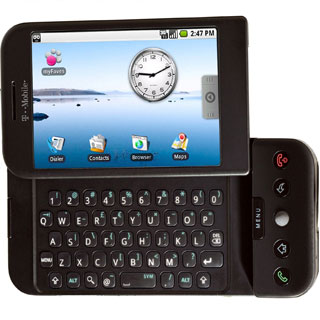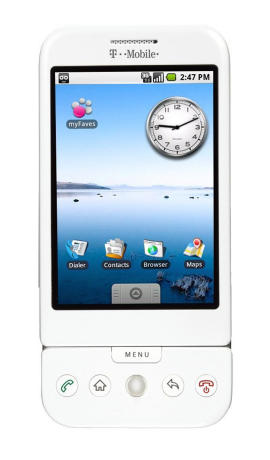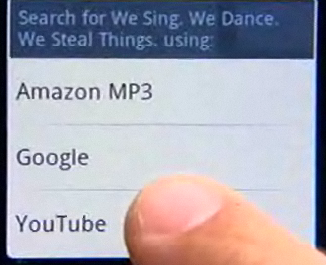 In case you haven’t heard, T-Mobile announced the world’s first — and for the time being, only — cell phone powered by Google’s open-source, mobile operating system today amid much pomp and circumstance.
In case you haven’t heard, T-Mobile announced the world’s first — and for the time being, only — cell phone powered by Google’s open-source, mobile operating system today amid much pomp and circumstance.
Cue the band.
You can spend hours thumbing through your bookmarks or RSS feeds looking for and reading about the new T-Mobile/Google phone, dubbed the G1. Most everybody is writing about the same thing — the specs, the looks, the apps, the Android operating system.
But there are a few posts out there looking at the G1 from various other perspectives — advertising, search, what’s missing, and so on. To save you a few minutes, we’ve combed through the basics, looked under the hood just a bit, hit on the basic apps, and compiled other posts of interest for your reading pleasure.
So off we go.
 Getting started with G1
Getting started with G1
The G1 will be available Oct. 22 for $179 ($20 less than the iPhone) with a two-year contract (same as the iPhone).
Unlimited data is $25/month or $35/month with unlimited messaging. A voice plan is required.
T-Mobile will likely have the Google phone exclusively for a few months, then other carriers and manufacturers (Motorola, Samsung, LG and one mystery phone maker) are expected to debut their plans/phones in early 2009.
The phone will be available in the UK in November and much of the rest of the world in early 2009.
For more info check out Sarah Perez’s post for ReadWriteWeb.
Under the hood with the G1
Much of what is under the hood we touched on in last evening’s last100 post. A few other items of note:
- of course the main difference with the iPhone is that the G1 sports a QWERTY slide-up keyboard, not a touchscreen keyboard
- the G1 will be a little heavier and thicker than the iPhone
- the “swipe” gesture is used on both the iPhone and G1; however, the G1 does not utilize the “pinch” gesture to zoom in/out on the touchscreen
- a 1 GB MicroSD card is preinstalled; the G1 supports an 8 GB MicroSD card
- the HVGA display is also a 3.17-inch, 65k color touchscreen
- for radio frequency buffs: GSM (800Mhz), GPRS (900), EDGE (1700). Wi-Fi and UMTS (1900) and HSDPA (2100) are supported (only 16 cities currently have T-Mobile’s 3G network)
- G1 allows dragging and dropping of pictures and text, which the iPhone lacks
It was manufactured for T-Mobile by HTC.
Looking at G1’s on-board apps
 Like the iPhone, the G1 ships with a few pre-installed applications (or Google Goodies) beyond the usual (contacts, browser, mail, chat), including:
Like the iPhone, the G1 ships with a few pre-installed applications (or Google Goodies) beyond the usual (contacts, browser, mail, chat), including:
- YouTube (duh)
- Maps (double duh)
- Search (duh x 3)
- Android Market
- Amazon MP3
- ShopSavvy (help people do comparative shopping)
- Ecorio (tracking your daily travel and carbon footprint)
- BreadCrumbz (step-by-step visual mapping and social network)
- Maps will utilize “compass mode” or “Street View,” giving you a live 3D map of where you need to walk (don’t bump into any streets signs as you walk and look at your G1)
- Push Gmail, which eliminates the need for a faux-Exchange server for push email. Remember: Google is already running mail servers for Gmail, while Apple operates MobileMe mail (formerly .Mac) on a much smaller scale and larger price tag (it’s $99 a year)
Google offers a video explaining its Gmail, contacts, Calendar, and GTalk applications.
 G1 links, links, links
G1 links, links, links
Scientific American’s take on the G1
The Guardian UK says the G1’s innovations are for tech heads, but it lacks the “wow” factor (agreed)
ZDNet weighs in on what mobile search means to Google (hint: more $$$)
The battle royale, the mano-a-mono fight between Amazon’s MP3 store and iTunes is on. What this might amount to is DRM (iTunes) vs. DRM-free (MP3 Store). So far, Amazon’s MP3 store has become the No. 2 digital music store but it hasn’t stolen iTunes’ marquee status. The game may change, however, with the MP3 Store on a mobile device. (See also: VentureBeat)
Lots of pretty pictures from CNET News, if you like seeing a bunch of dudes standing around holding cell phones.
Naturally, there’s always a naysayer in the crowd. Crave tells us what we didn’t get with the G1.
A fairly in-depth look at the software inside the G1 from CNET.
 InfoWorld’s take that Google Android is all about advertising, not the enterprise (who thought it was about the enterprise?)
InfoWorld’s take that Google Android is all about advertising, not the enterprise (who thought it was about the enterprise?)
The Wall Street Journal’s and New York Times’ (and here) takes on the G1 because, after all, they are the papers of record. TechCrunch is sorta the blog of record. Coverage from Engadget and Gizmodo, the gadget blogs of record. And Boing Boing is kinda the pop culture blog of record (but what does Cory Doctorow think?).
Uncle Walt Mossberg of the WSJ gives his first impressions, but where is David Pogue of the NYT? And no coverage would be complete without GigaOM, although this post is Om-less.
Forbes (basic coverage) is already calling winners and losers with the introduction of the G1, but as far as we can tell they’ve yet to call the 2008 U.S. presidential election. Forbes also brings us perspective from other open source projects, the LiMo Foundation and Mozilla.
TechDirt, naturally, digs up the dirt on the T-Mobile G1 plan, citing a 1 GB per month data limit (via Broadband Reports). Guess it pays to read the fine print, especially when dealing with shifty wireless carriers.
Leave it up to the Apple blogs (one being the AppleInsider) to reinforce the fact that Apple has a year-plus head start on Google and that the G1 will have little impact on the iPhone initially. We’ll see about that. Macworld, however, provides a nice FAQ to answer all your G1 questions.
last100 editor Steve O’Hear also notes that the Gphone and Android will fuel the social web. No question the G1, with the iPhone, are the Facebookers, MySpacers, and Twitterers phones of choice.
And lastly — because, by now, we’ve all had enough — leave it up to The Register to invoke Jobs, the Lord, and Satan in a post about the Google phone. If the iPhone was known as the “Jesus phone,” is the G1 really the “Satan phone?”
Seriously.

Just one correction on your bands:
EDGE is 1900 (not 1700). It’s the UMTS/HSPA that’s 1700/2100 (that’s the AWS band that t-mo has)
good article guys!
I’m wondering what the GPS functionality is like? Is it closer to a full GPS, or still hobbled like Apple’s?